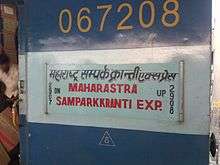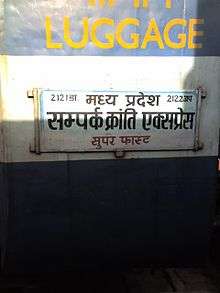Sampark Kranti Express
|
| |
| Overview | |
|---|---|
| Main Operation(s) | Connects national capital/Chandigarh with state capitals/big cities |
| Fleet size | 19 |
| Parent company | Indian Railways |
| Technical | |
| Gauge | Broad Gauge |
| Operating speed | 110 km/h (68 mph) maximum |
Sampark Kranti Express[1] trains are a series of super-fast trains operated by the Indian Railways providing quick connectivity to the national capital, New Delhi.
Overview
The words Sampark and Kranti are borrowed from Sanskrit. Sampark(Devanagari:-सम्पर्क) means Contact and Kranti(Devanagari:-क्रान्ति ) means Revolution. The combined name denotes the steps taken by Indian Railways to provide high speed train connections from cities around India with the National Capital through the provision of non-air conditioned express trains with few stops and operating at high speeds. A similar capability had been introduced earlier on the Rajdhani series of super-fast. However, these trains were completely air-conditioned and hence quite expensive.
The Rajdhani and Shatabdi series are the fastest trains in India in terms of average journey speeds. The Sampark Kranti trains operate at slower average speeds than the Rajdhani and Shatabdi series yet still provide high speed options at normal prices due to their few stops and relatively faster speeds compared with other non-Rajdhani Express express trains and non-Shatabdi Express express trains although initially they ran non stop once they left their respective states.
The Railway Ministry (India) at the time Nitish Kumar in the interim Railway Budget of 2004-05 announced the launch of Sampark Kranti Express. The trains in the Sampark Kranti series connect the Indian states to the national capital city of New Delhi. Sampark Kranti trains charge the same fare as regular/superfast trains on the Indian Railways rail network and do not provide any special facilities not available in regular Express trains. The initial decision of non-stop run of this Express series of trains was cut short and was given way to commercial stopping outside the states.[2] The trains aim at reducing travel time without compromising on passenger comfort.[3]
Initially eighteen trains were launched and the count was later increased. The Karnataka Sampark Kranti Express from Delhi Hazrat Nizamuddin to Yesvantpur was the first train which was launched on 8 February 2004.[2]


List of services
| Sr no. | Train Name | Distance Km. |
|---|---|---|
| 1 | Andhra Pradesh Sampark Kranti Express | 2302 |
| 2 | Bihar Sampark Kranti Express | 1172 |
| 3 | Chhattisgarh Sampark Kranti Express | 1281 |
| 4 | Goa Sampark Kranti Express | 2160 |
| 5 | Gujarat Sampark Kranti Express | 1085 |
| 6 | Jharkhand Sampark Kranti Express | 1306 |
| 7 | Karnataka Sampark Kranti Express | 2276 |
| 8 | Kerala Sampark Kranti Express[4] | 3465 |
| 9 | Madhya Pradesh Sampark Kranti Express | 909 |
| 10 | Maharashtra Sampark Kranti Express | 1366 |
| 11 | Odisha Sampark Kranti Express | 1799 |
| 12 | Porvottar Sampark Kranti Express (Guwahati) | 1904 |
| 13 | Rajasthan Sampark Kranti Express | 685 |
| 14 | Tamil Nadu Sampark Kranti Express | 2677 |
| 15 | Uttar Pradesh Sampark Kranti Express | 695 |
| 16 | Uttar Sampark Kranti Express | 655 |
| 17 | Uttarakhand Sampark Kranti Express | 239/278 |
| 18 | West Bengal Sampark Kranti Express | 1448 |
| 19 | Poorvottar Sampark Kranti Express (Silchar) | 2305 |
| 20 | Karnataka Sampark Kranti Express | 2884 |
| 21 | Karnataka Sampark Kranti Express | 2,865 |
| 22 | Uttar Pradesh Sampark Kranti Express (Khajuraho) | 604 |
See also
References
- ↑ "Sampark Kranti Express trains". Government of India. Press Information Bureau. Retrieved 1 October 2004.
- 1 2 "Sampark Kranti Express Train". Retrieved 17 June 2013.
- ↑ "18 Sampark Kranti trains mooted, first train from Feb 8". The Tribune. 20 January 2004. Retrieved 17 June 2013.
- ↑ "New Kerala Sampark Kranti Express to be introduced tomorrow". Government of India. Press Information Bureau. Retrieved 29 March 2005.
External links
| Wikimedia Commons has media related to Sampark Kranti Express. |